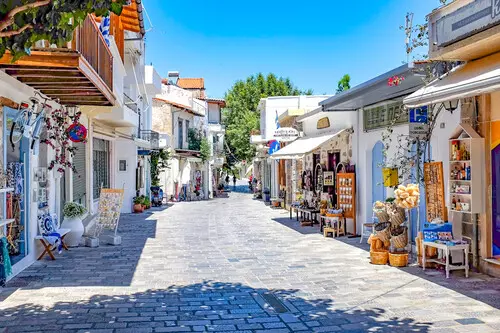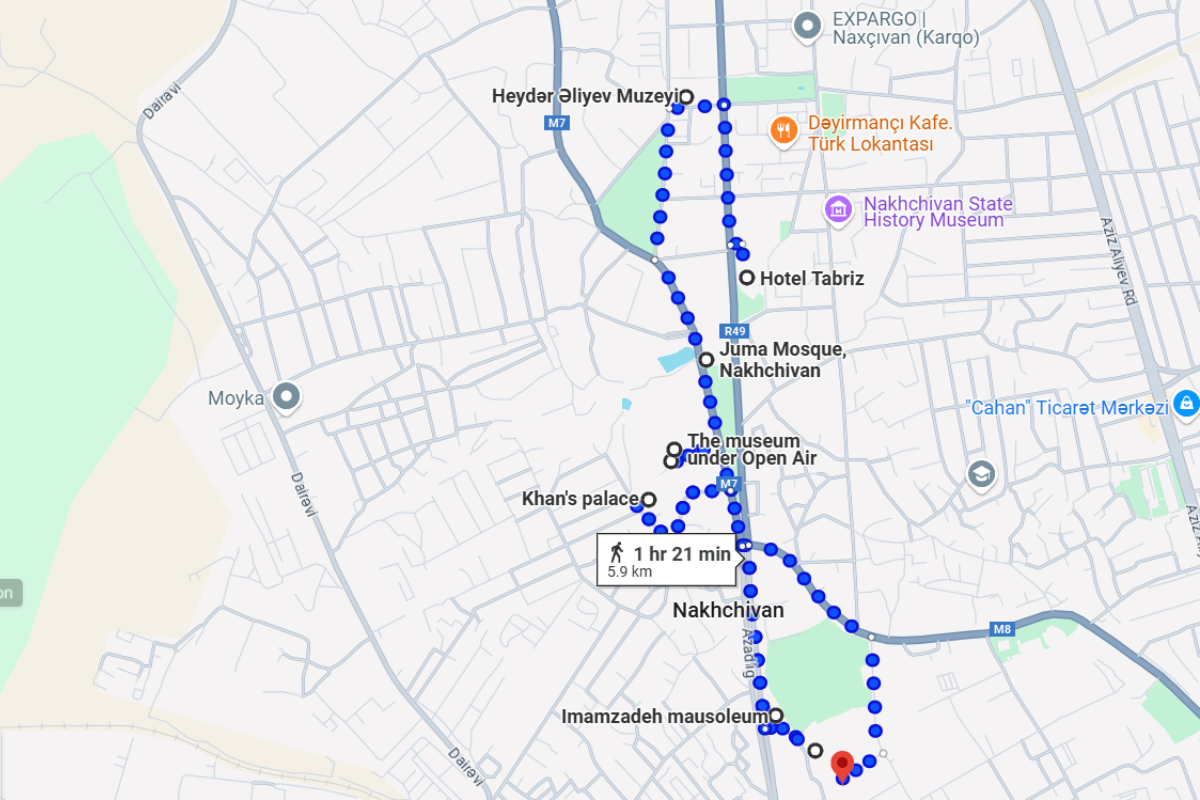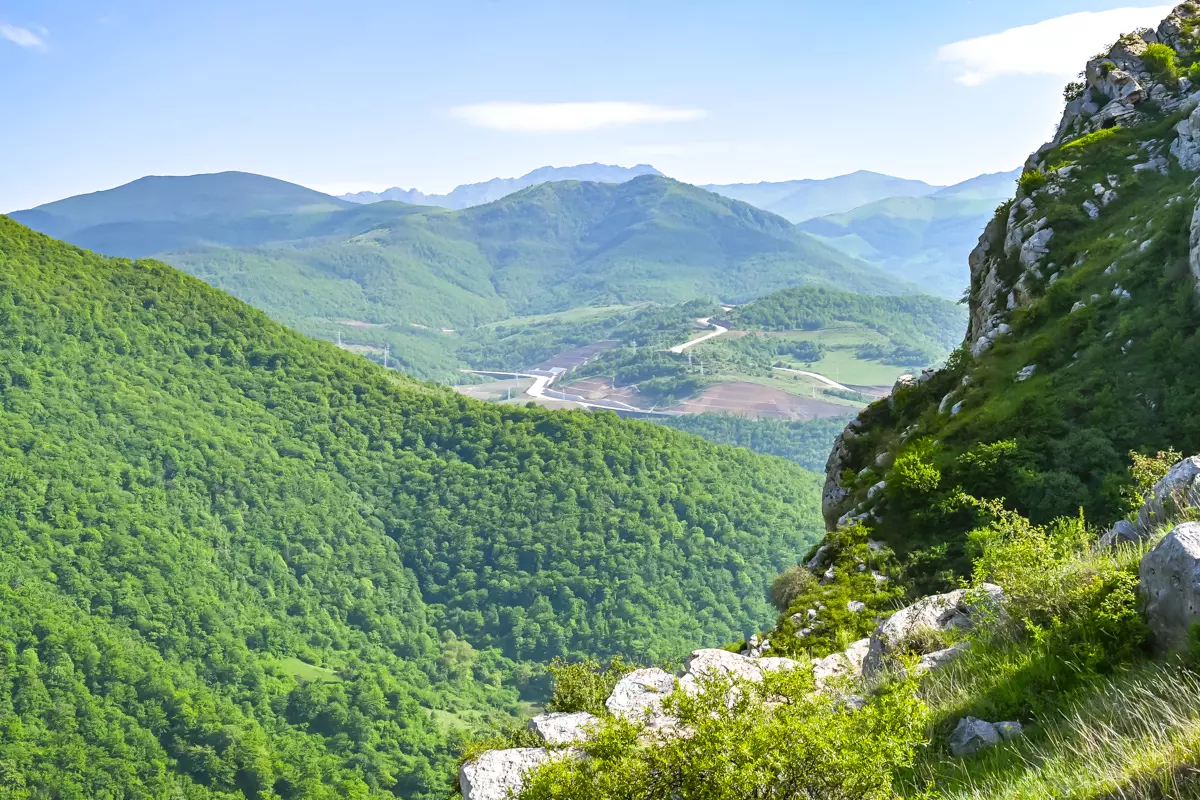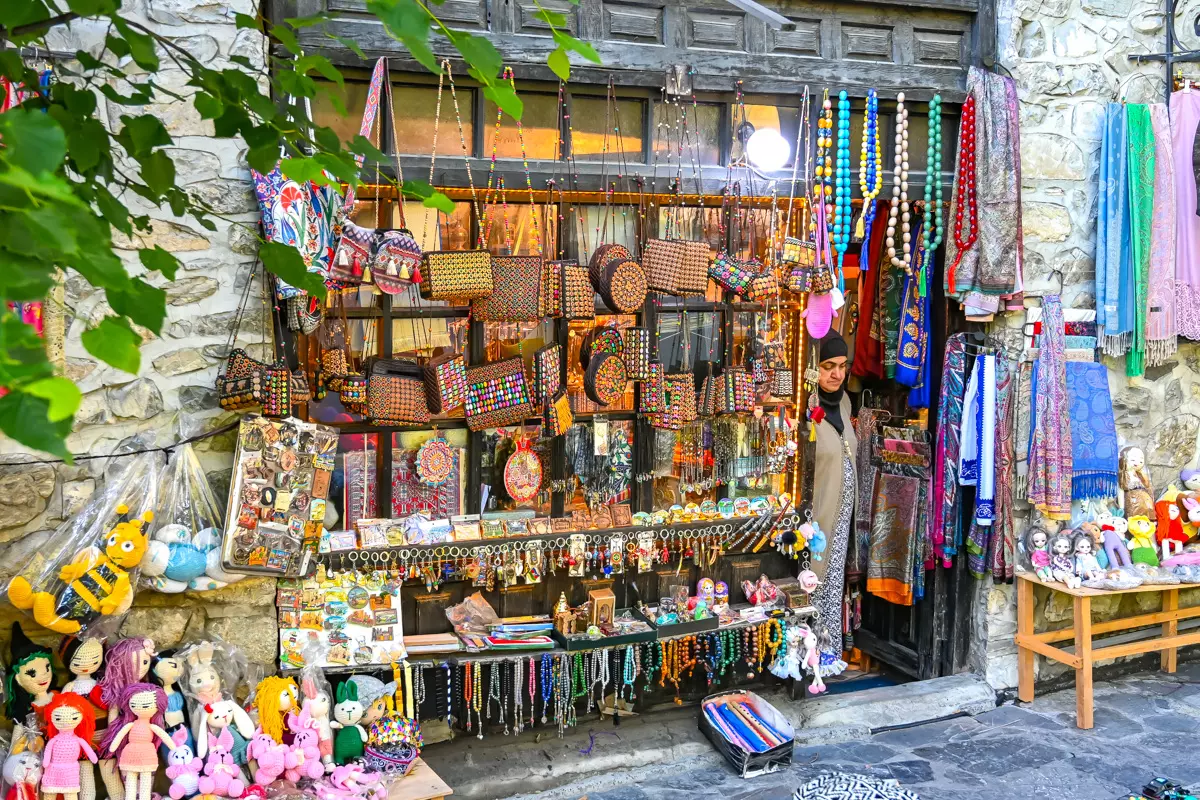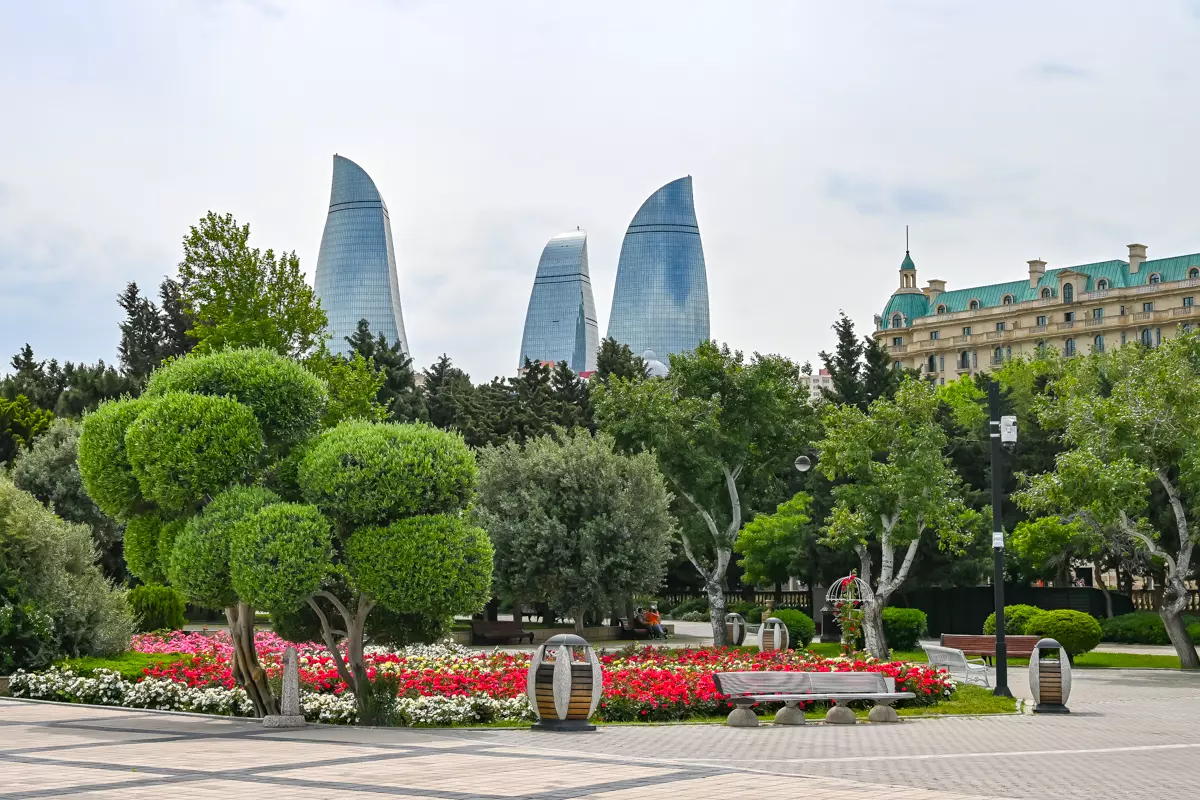Explore Nakhchivan, Azerbaijan: 2-Day Itinerary & Top Sights
The mysterious and little-visited Nakhchivan region, located between mountains and steppes, is one of the most fascinating yet least known areas of Azerbaijan. This autonomous republic is separated from the main part of the country by Armenia and had long been on my list of places to visit, but it was only this May that I finally managed to reach it.
Traveling through this region feels like a journey through time. Ancient mausoleums, sacred sites, Soviet remnants, and breathtaking nature all come together here.
In fact, it doesn’t really matter whether you’re drawn to history, nature, or just want to see something unique and unusual. This two-day route will help you discover the best of Nakhchivan. Ready to set off on a journey through Azerbaijan’s hidden gem that only a few know about? Let’s begin!
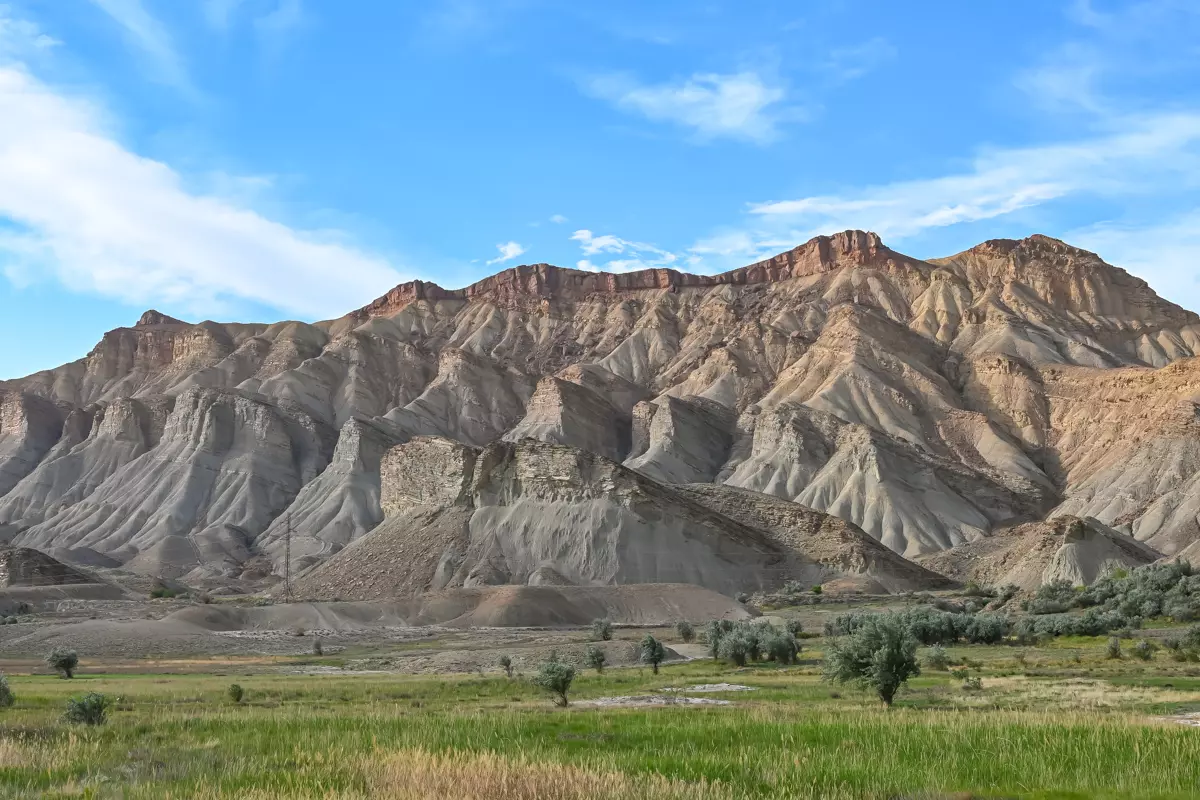
Day 1: Alinja Castle, Ashabi Cave & City of Nakhchivan
Alinja Castle
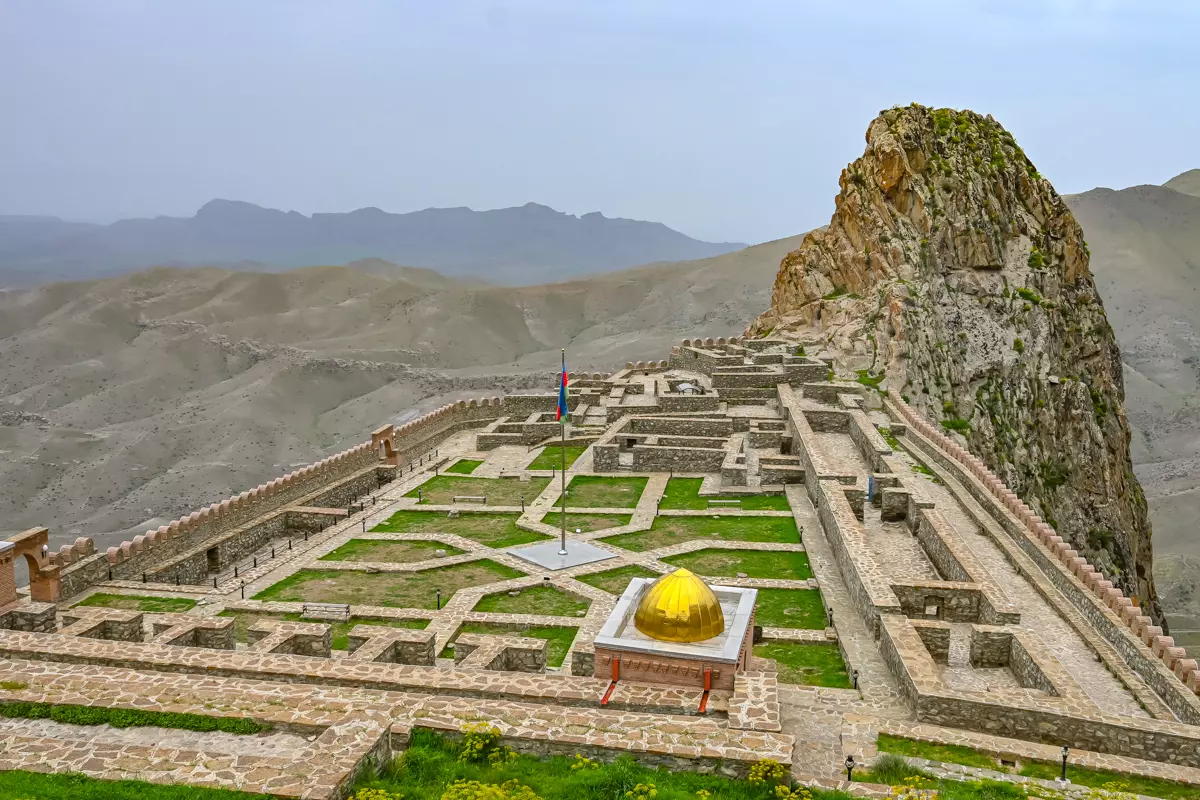
On your first day, head straight from the airport or your hotel in Nakhchivan city to Alinja Castle, after agreeing on a price with a driver. This is one of the most iconic sites in the entire region, often called The Machu Picchu of the Caucasus – and for good reason. The fortress stands on the slope of a high cliff, so from the very first step, you’ll need to rely on your legs.
The climb requires effort, but every step is worth it. The higher you go, the more opens up – mountains, valleys, and tiny villages far below.
Before or after the climb, it’s worth stopping by the small museum. There you can see reconstructed defense elements, ancient artifacts, and learn more about the historical importance of this place.
Good To Know: The climb to the top takes around 40–45 minutes. You should plan at least 2 hours for this site. Also, don’t forget to bring water – the climb, especially in summer, can be very exhausting.
Ashabi Kahf Cave
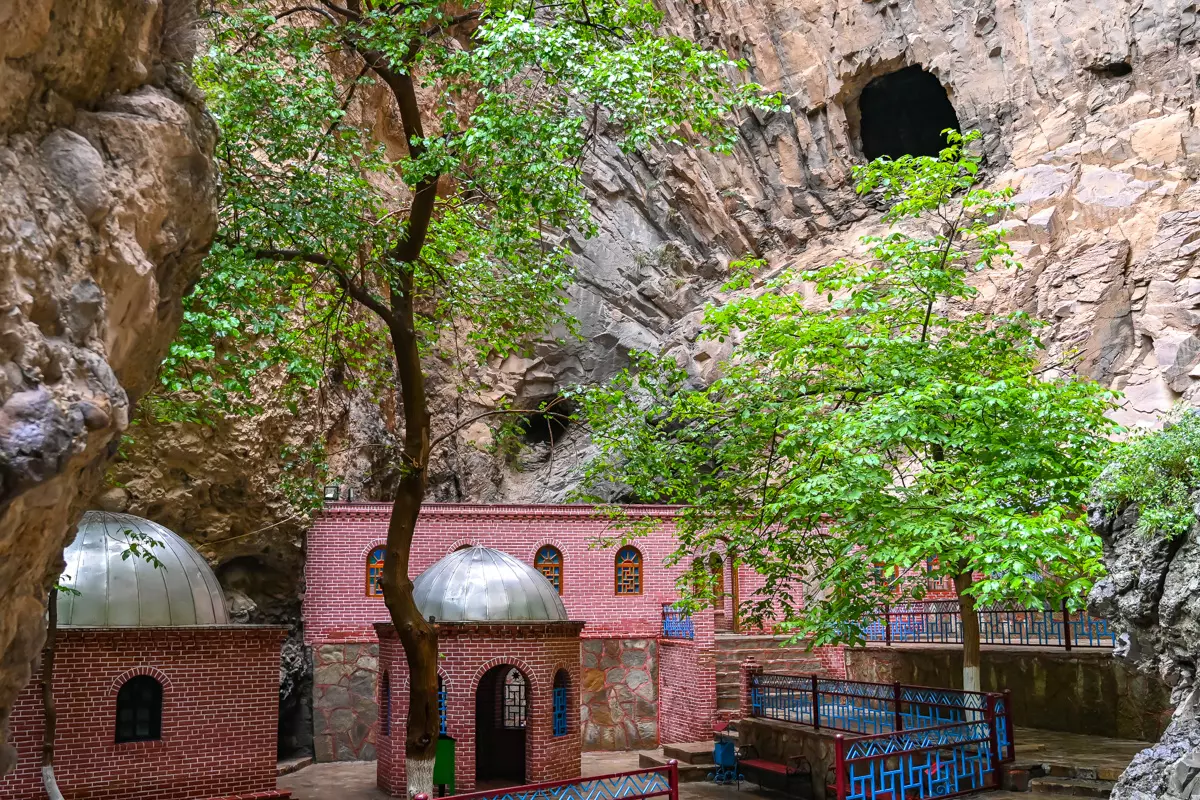
From Alinja, continue deeper into the mountains – about a 40-minute drive will take you to Ashabi Kahf Cave. This is one of the most revered places in all of Azerbaijan, attracting both pilgrims and curious travelers. According to legend, seven brothers, fleeing religious persecution, hid in the cave and slept there for several hundred years.
The cave is located on a mountain, and the path leading up consists of carved stone steps – so get ready for another climb. Along the way, you’ll enjoy panoramic mountain views and breathtaking natural landscapes.
Right next to the cave stands a small, modern mosque, used by the faithful for prayer. Nearby are rest areas where pilgrims and visitors can sit down. The cave itself is a natural crevice in the rock that you can enter. Inside, you may notice symbolic candles and small notes with written prayers. There isn’t much space inside, but the cave entrance offers a beautiful view of the mosque below.
Good To Know: The best part is that Ashabi Kahf – like many other attractions in Nakhchivan – is free to visit, so you don’t need to buy any tickets.
The City of Nakhchivan
In the afternoon, take some time to explore Nakhchivan city itself. Everything is close by, so you can easily continue your journey on foot. I started my route at the Heydar Aliyev Museum. Below, I’ve described each place I visited, and at the bottom, you’ll also find the map I used.
Heydar Aliyev Museum
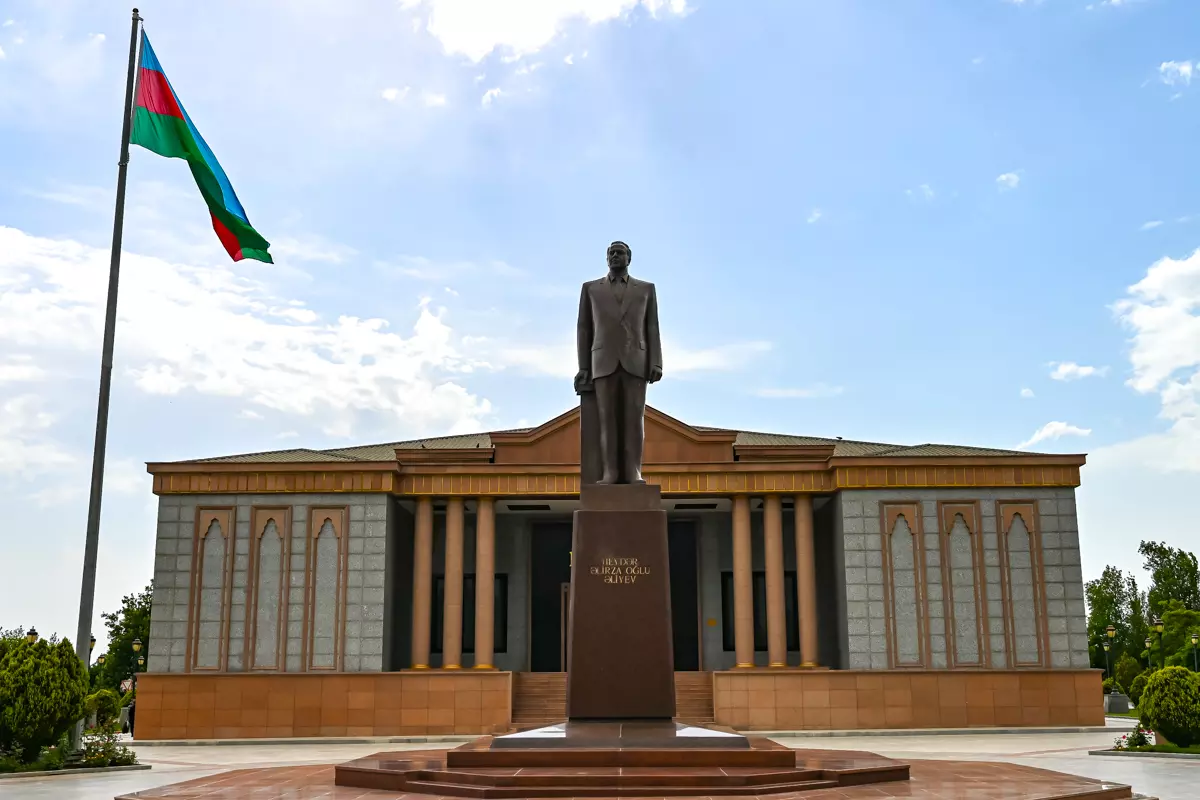
This museum is dedicated to one of Azerbaijan’s most prominent leaders – Heydar Aliyev. It’s a modern and spacious building with large exhibition halls. Inside, you’ll find plenty of photographs, video footage, and exhibits showcasing Aliyev’s political career and his contribution to the country’s independence.
Although the theme may seem quite official, the exhibition is interesting even for those who aren’t particularly into politics. The museum is a great starting point before diving into the older parts of the city’s history.
If you’re traveling with kids or aren’t really a museum enthusiast – there’s a small green park right next to the museum where you can take a break.
Tip: If you’re not into museums, 15–20 minutes is enough for a quick visit. The building itself is impressive from the outside too, so it’s worth a short stop even if you don’t go inside.
Juma Mosque
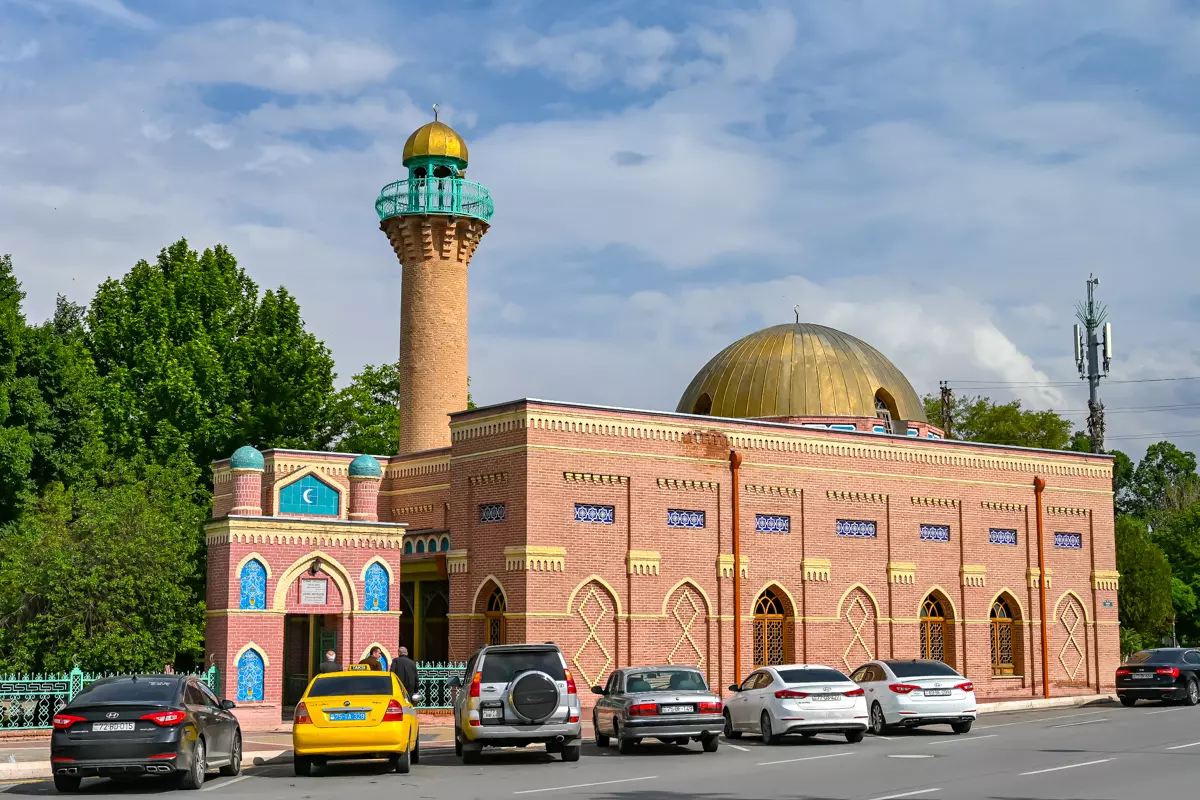
Just a 10-minute walk from the museum, you’ll reach Juma Mosque – one of the oldest in the city. This beautiful, pink-colored structure features classic Islamic architecture, with subtle ornamentation and elegant minarets.
If you arrive outside of prayer times, feel free to step inside. The locals are friendly and often invite visitors to stay a bit longer, especially if they see you’re genuinely interested. The mosque’s courtyard is a perfect place for a quick break or a moment of rest.
Momina Khatun Mausoleum
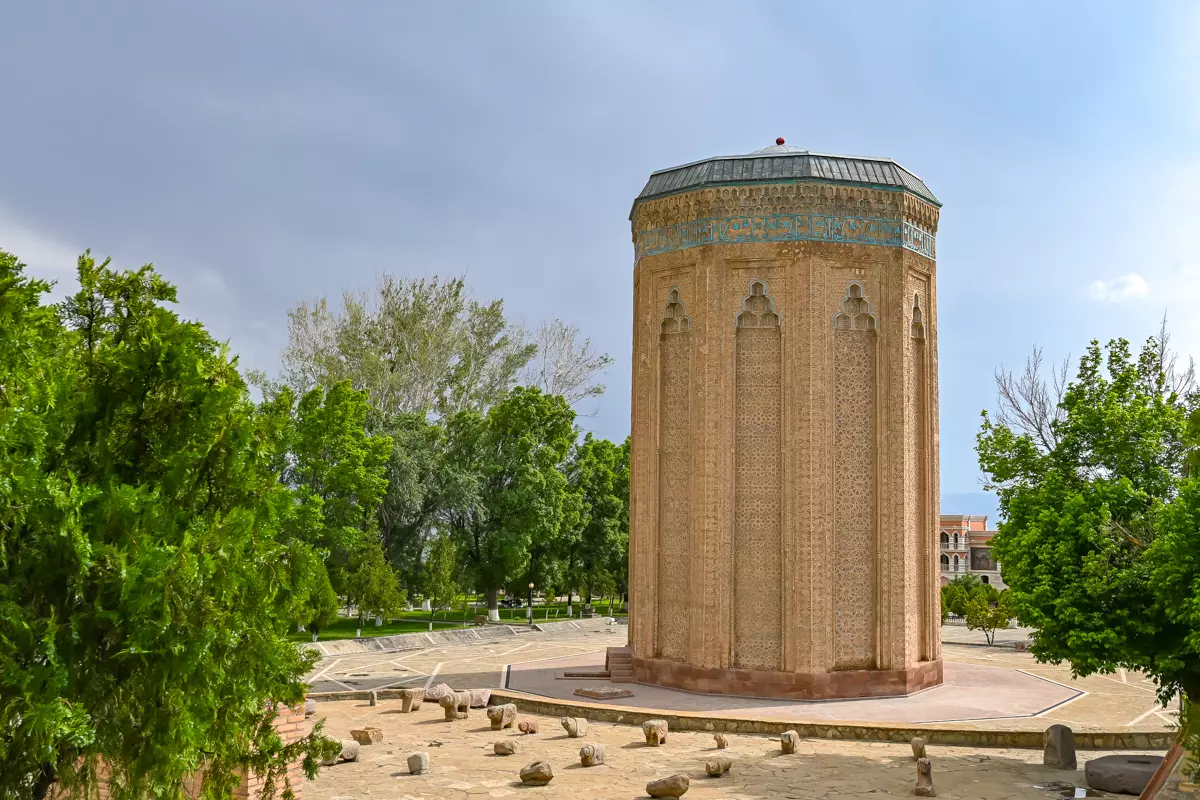
This is one of the most photographed landmarks in the city. The mausoleum, built in 1186, serves as the tomb of Momina Khatun, the wife of ruler Eldegiz. Architect Ajami Nakhchivani, one of the most renowned medieval masters in Azerbaijan, designed it. The structure stands as a key example of Seljuk-era architecture in the region.
Next to the building, you’ll find a small square with various stone sculptures and benches. Inside, a small museum awaits.
Khan’s Palace
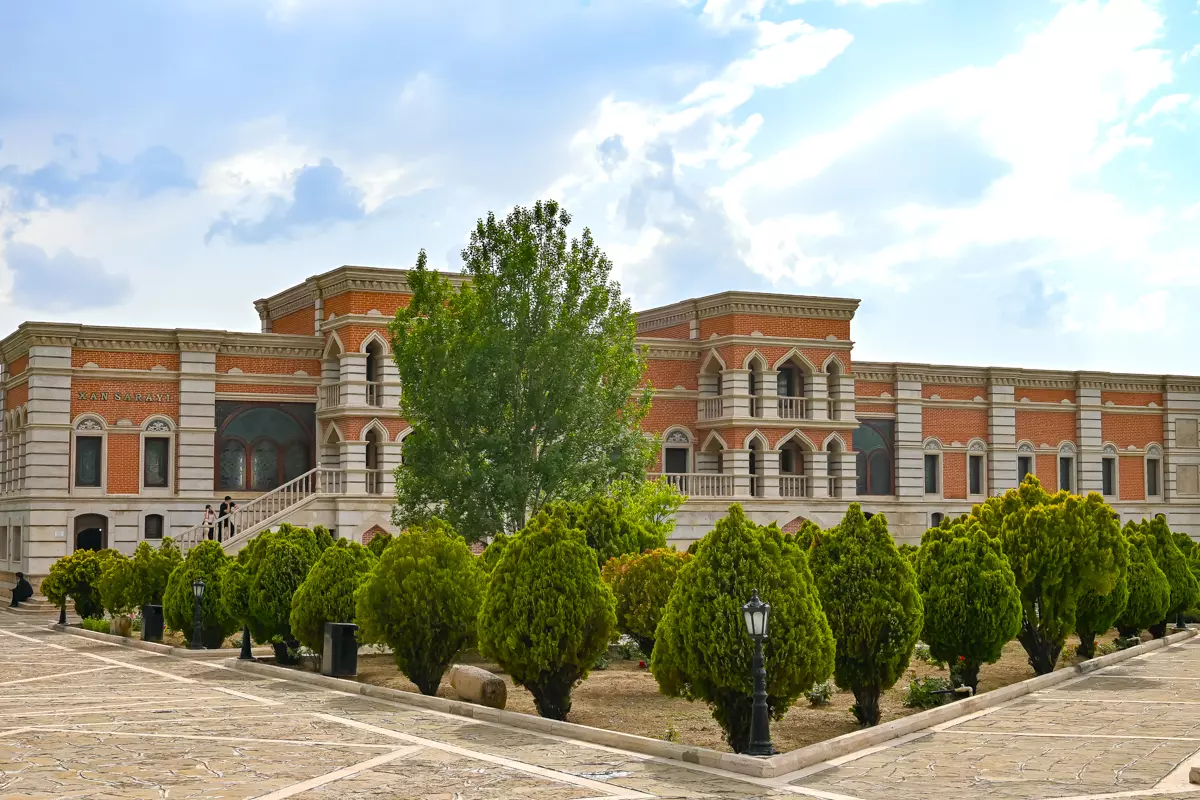
Your next stop is the nearby Khan’s Palace – the only surviving 18th-century government building in the region. The khan built the palace as his residence during a time when Nakhchivan had its own autonomous administration. It served not only as a residence but also as an administrative center where political meetings took place.
Local materials – clay plaster, wood, and stone – were used in its construction. The windows feature stained glass with intricate, colorful designs that were assembled without nails or glue. Inside, you’ll see original wooden ceilings, niches, wall-mounted cupboards, and carved door frames.
Today, the building houses a museum. Exhibits include items from the khan’s era. You can see household objects, textiles, fragments of historical documents, weapons, and antique furniture. Some displays recreate original rooms, such as a reception hall or a bedroom.
Imamzadeh Mosque
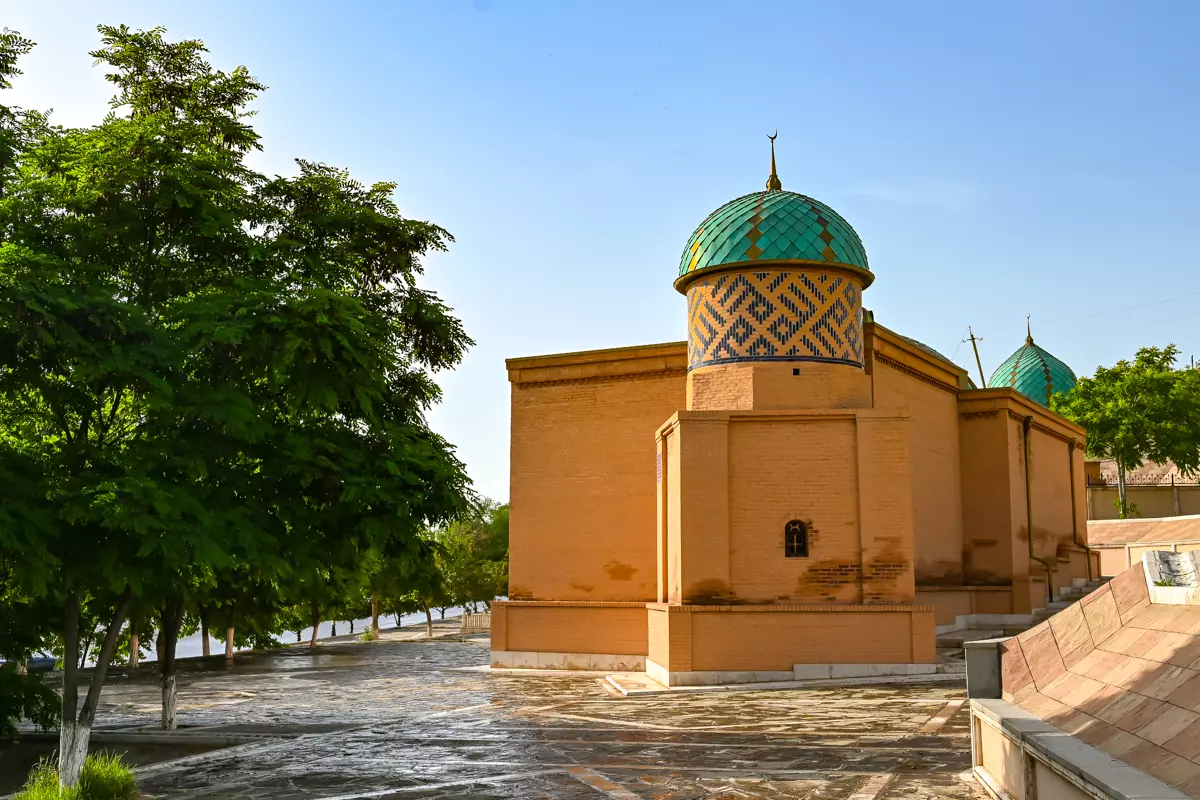
Continuing along my route, you’ll come to Imamzadeh Mosque. Its dome and brickwork details have been restored multiple times, but the overall appearance has remained authentic.
Yezidabad Fortress
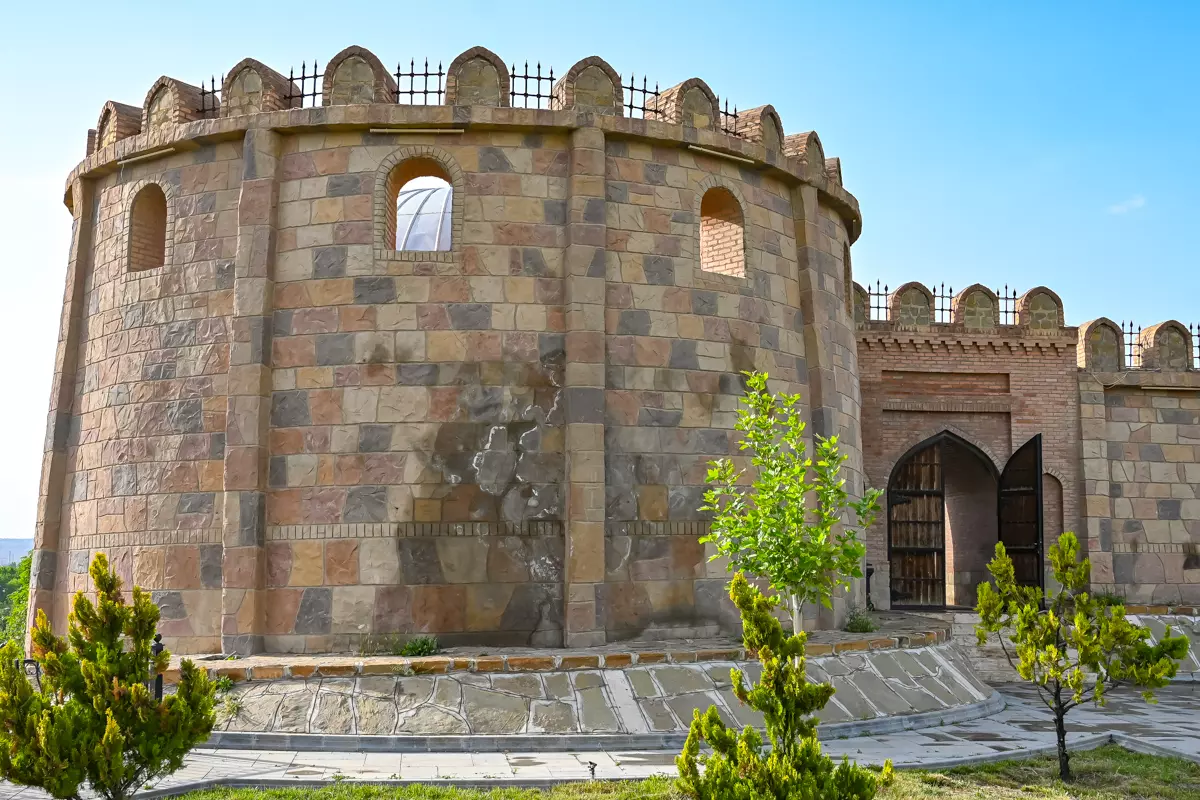
Next, head to Yezidabad Fortress – once a key part of Nakhchivan’s defensive system. Built on a natural hilltop, the fortress provided a wide view of the surrounding valley and the Aras River’s direction. While the exact construction date is unknown, experts believe the foundations may date back to the medieval period.
From the highest points of the fortress, you’ll enjoy panoramic views of the city, and on a clear day, you can spot the Aras Valley and the mountain ranges beyond the border.
Tip: The best time to visit is just before sunset. You’ll get especially beautiful photos not only of Noah’s Tomb but also of the nearby landscape.
Noah’s Tomb
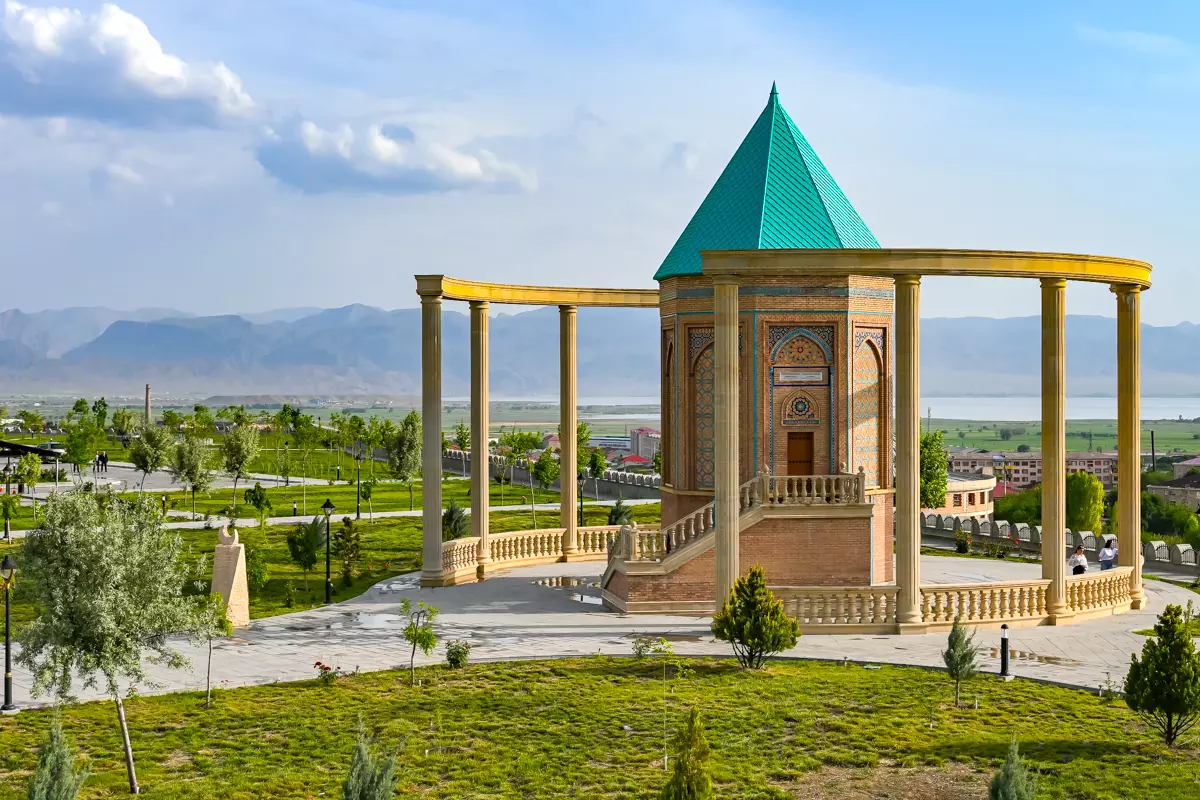
Right next to the fortress lies the final stop of the day – Noah’s Tomb, one of the most symbolic sites in all of Nakhchivan. According to local legend, after the flood, Noah didn’t only land on Mount Ararat, but also came to this area.
What’s interesting is that local residents treat this place with great reverence. Many believe Noah is truly buried here – a version supported by local sources and ancient writings found in Caucasus region chronicles. The site is even mentioned in some Islamic texts as one of the possible resting places of Noah.
Even if you’re skeptical of such stories, the site is fascinating as a cultural and spiritual symbol.
Note: To complete the full day’s route, you’ll need about 8–9 hours, so make sure to plan your time wisely.
Click the map to see the day’s route on Google Maps.
Day 2: Mausoleums, Salt Mountains & Tea with Locals
Qarabaghlar Mausoleum
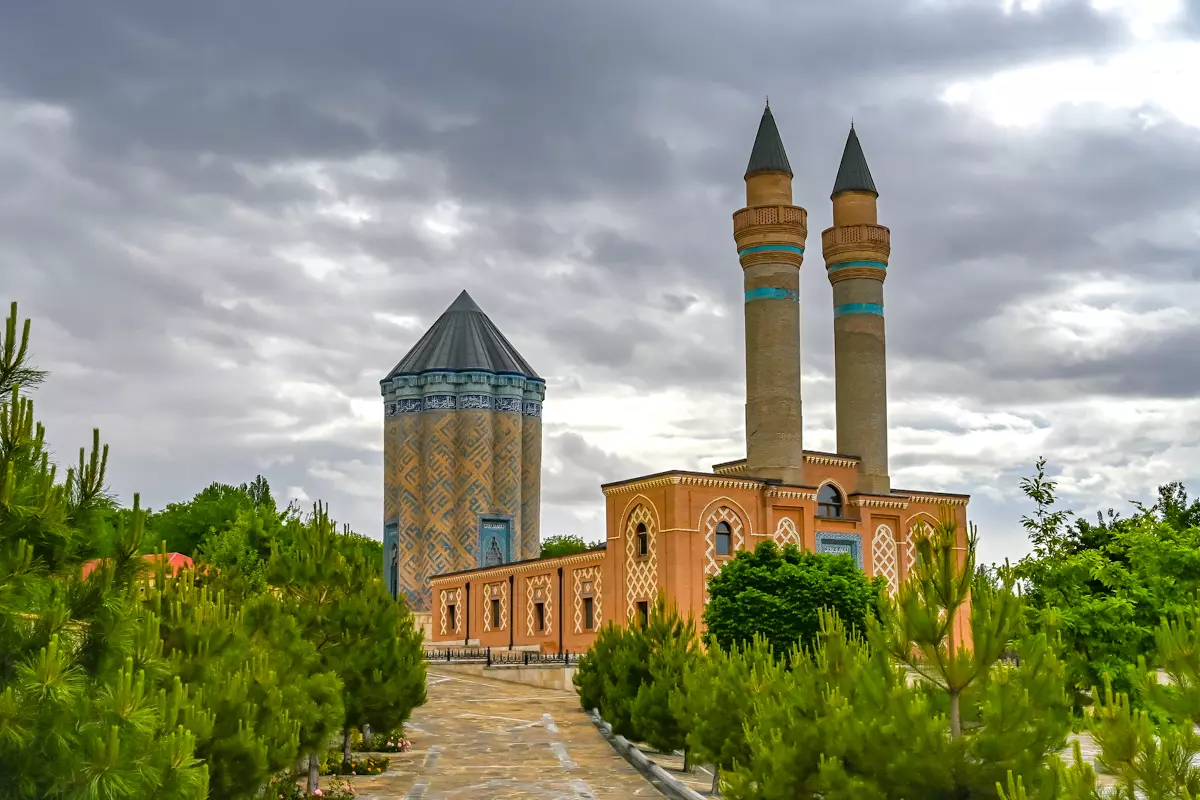
Start your second day with a visit to the Qarabaghlar Mausoleum, considered one of the most unique structures in the region. It stands out with its tall minarets, Turkish-style brick ornamentation, and decorative inscriptions that catch the eye from afar.
In the nearby building, there’s a small museum that provides more information about the mausoleum’s history, construction period, and religious significance. Even if you’re not a big fan of museums, it’s worth a quick visit – especially if you’re interested in history or Islamic architecture.
Duzdag Therapy Center
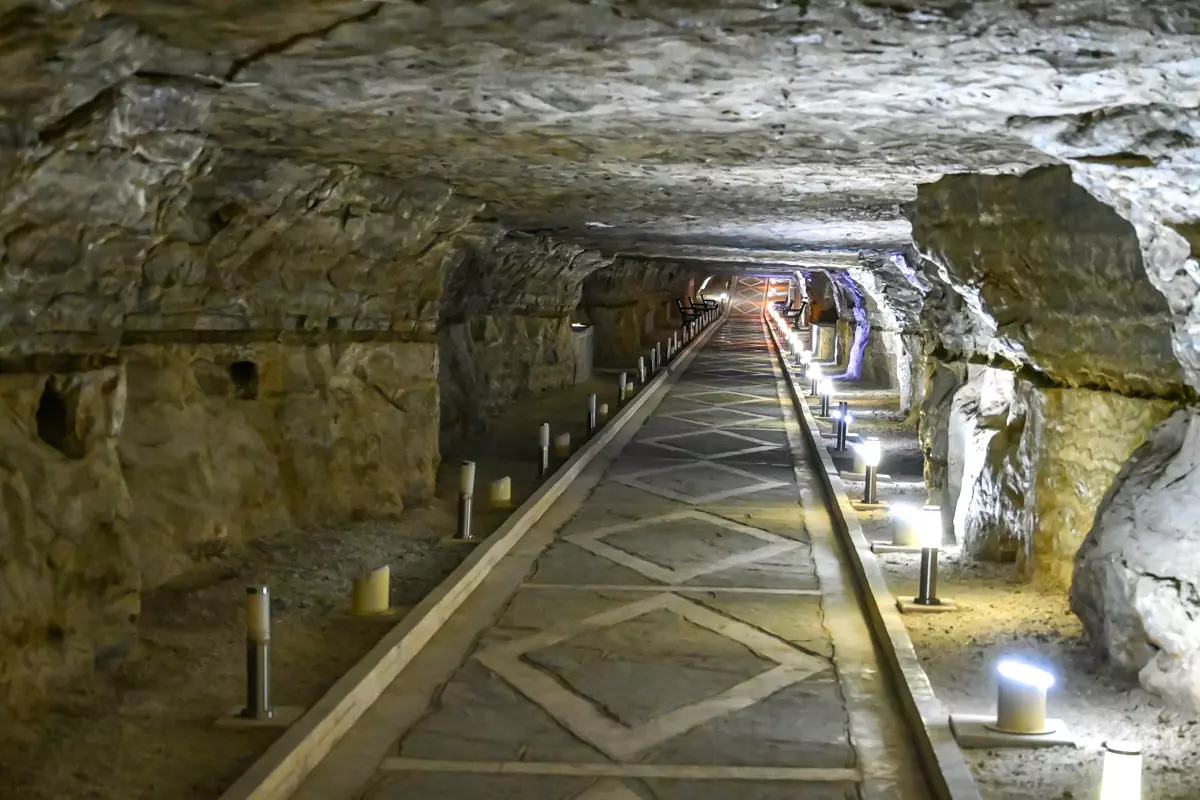
Next, head to the Duzdag Therapy Center, located in a former salt mine. People come here to treat asthma, respiratory issues, and other chronic conditions. It’s one of the most unexpected, yet memorable places in the region.
Underground, there are spacious halls with beds and chairs, where visitors spend time simply breathing in the salty air. There are no special procedures – the environment itself does the work. Spending time in this salt-rich air can improve respiratory health even for those without any medical conditions.
What I remember most was a brief conversation with one of the staff members, who gladly talked about the place, the visitors, and even showed me a few areas that tourists usually don’t get to see.
Tip: After visiting the center, walk to the end of the parking lot – from there, you’ll see the salt mountains rising in the distance. A great spot for a few good shots.
Ordubad
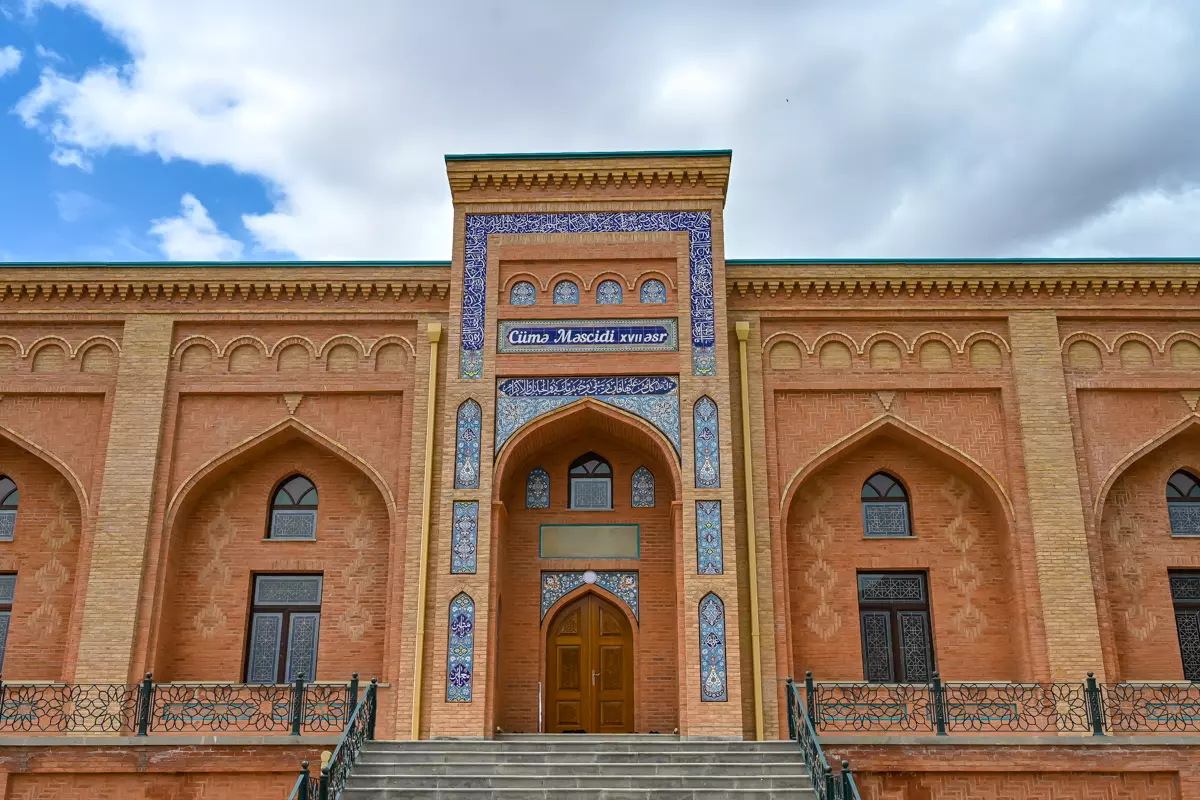
The next stop is the ancient city of Ordubad, known for its narrow streets, fruit orchards, and incredibly cozy atmosphere. It’s one of the oldest cities in the region and has a unique layout – each neighborhood traditionally had its own mosque, water spring, and communal courtyard for gatherings.
Take a walk through the town center and stop by the local market, where you’ll find fresh pomegranates, dried fruits, nuts, and other local products. Some women also sell handmade crafts.
I spent a few hours in Ordubad not only observing local life but also playing checkers with residents and chatting with them. It was one of my most memorable moments from my trip to Nakhchivan
Vanand Village
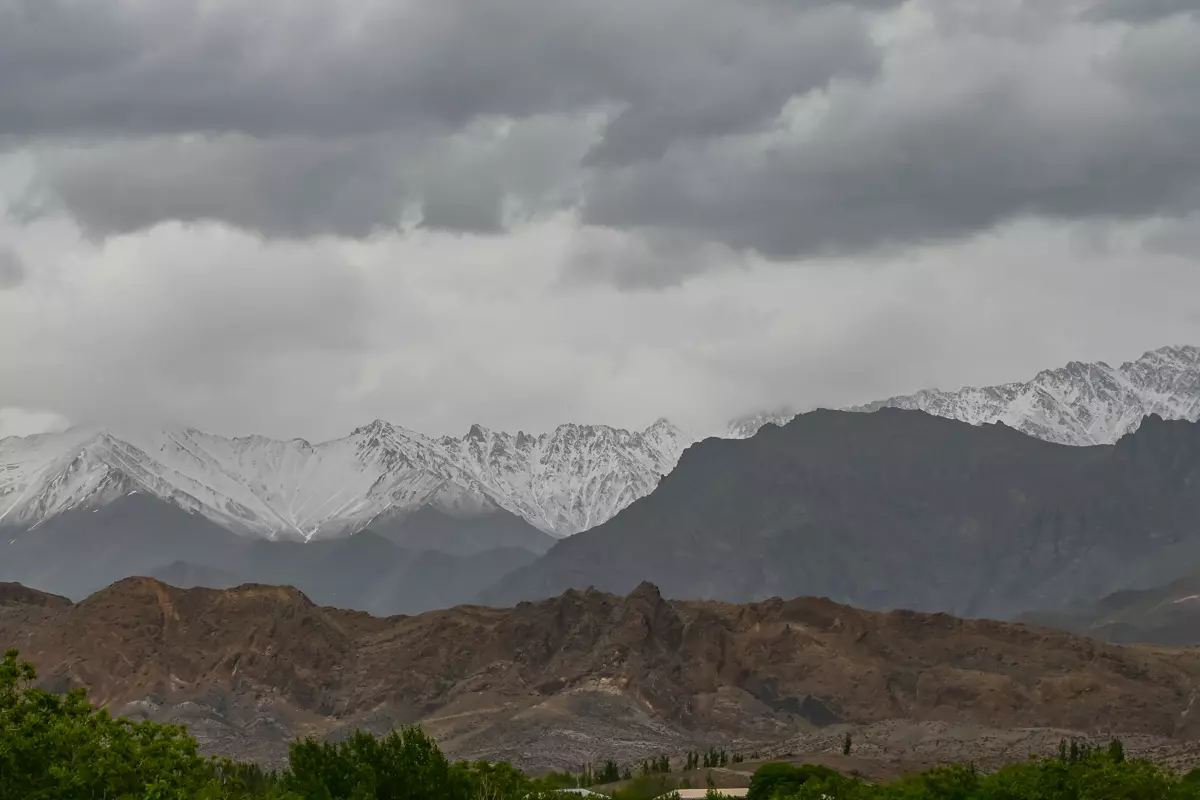
On your way back toward Nakhchivan City, ask your driver to stop in the small village of Vanand — a quiet settlement that’s home to Su Sesi, a great local restaurant. It’s well-liked by locals, but still remains off the tourist radar.
Here, you’ll find a variety of traditional dishes – from grilled lamb to dolma and rice with dried fruits. The food is fresh, and the service is genuinely warm.
Gulustan Mausoleum
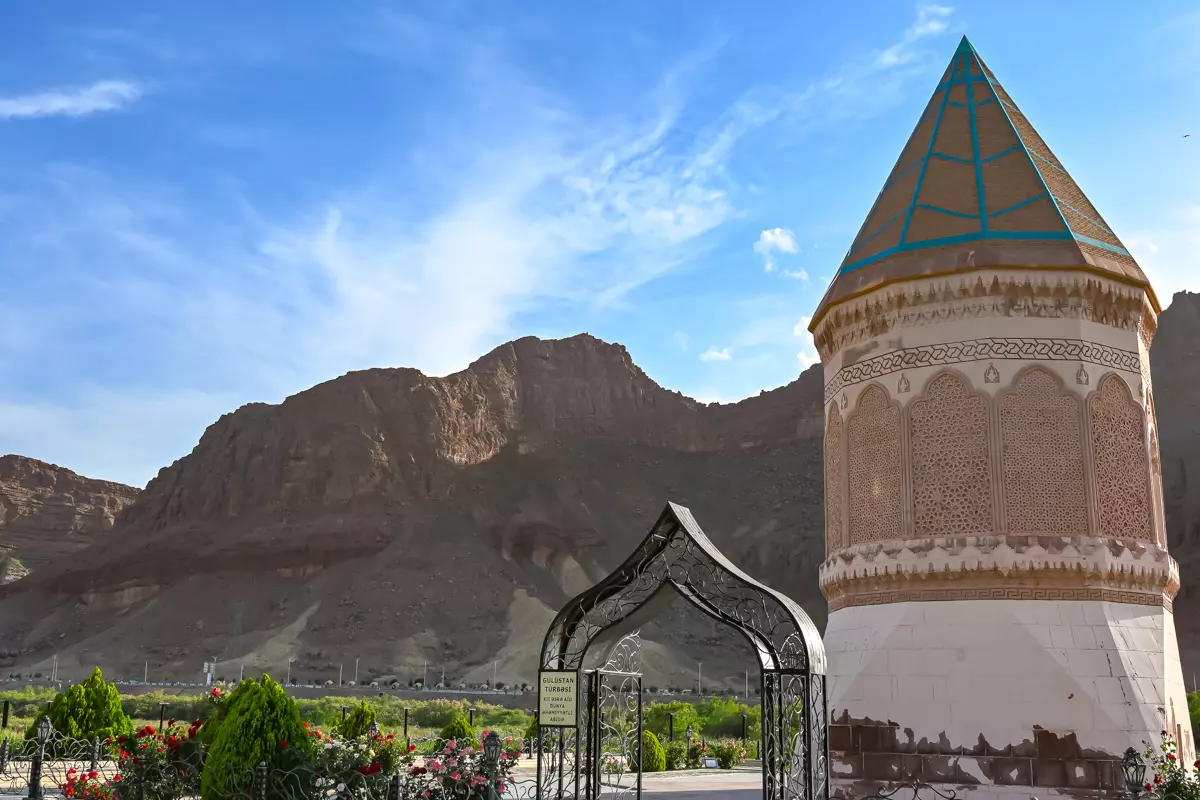
For your final stop of the day, I recommend the Gulustan Mausoleum, located right near the Iranian border. This place is not only beautiful but also special because of its location – standing here, you can clearly see the territory of Iran on the other side.
It is said that the mausoleum dates back to the medieval period and once served as a burial site for local religious leaders.
Also read: Sheki, Azerbaijan – A Complete Travel Guide
Extra Day: Lake Batabat
If you have an extra day or your flight is in the late evening, be sure to visit Lake Batabat. It’s one of the most beautiful natural spots in the entire Nakhchivan region.
The lake lies high in the mountains, at around 2,000 meters above sea level, so the air is always cooler and fresher there. The drive takes you along winding mountain roads, with increasingly impressive views along the way.
Locals love to come here in the summer – to escape the heat or simply spend time in nature. Since there are few tourists, the area has remained unspoiled and natural.
Tip: Bring a warmer layer – even in summer, it can get chilly in the mountains. If you plan to stay longer, take some water and snacks with you.
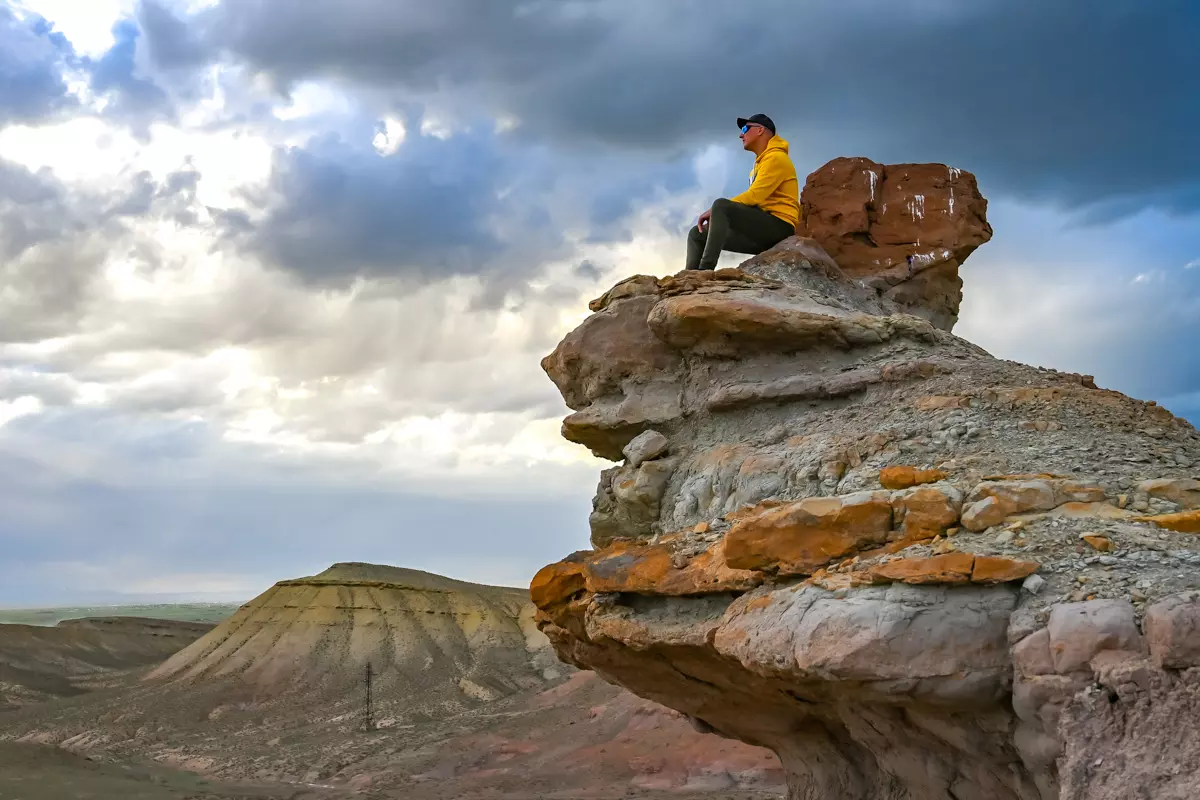
Want to discover a view like this? This hidden gem isn’t found online — only the locals know about it. Full details inside PDF!
Get Your Exclusive Azerbaijan Travel Tips PDF Now!
Based on my personal experience, this concise guide is packed with exclusive tips to help you save time, avoid common mistakes, and make the most of your trip to Azerbaijan. Here’s a sneak peek at what’s inside:
- 🚶♂️ Local experiences – authentic cultural activities and experiences that will help you immerse yourself in Azerbaijani traditions.
- 🍽️ Some best restaurants – places I visited and highly recommend.
- 💡 Exclusive tips – where to change money, what to remember, and mistakes to avoid – advice you won’t find anywhere else.
- 🔗 Helpful links – Google Maps, websites for reservations, and other links that will make your trip significantly easier.
- 🗺️ In-depth travel info covering not just touristy Azerbaijan, but also lesser-known regions like Nagorno-Karabakh and Nakhchivan.
How To Get To Nakhchivan, Azerbaijan
Nakhchivan is a unique region of Azerbaijan, physically separated from the rest of the country. Because of this, you can only get there by air, which makes the journey more interesting. Flights operate domestically within Azerbaijan, so the best option is to first fly to Baku and then take a flight to Nakhchivan. At the moment, you can’t travel overland – the borders with neighboring Iran and Armenia are closed and inaccessible to tourists.
How To Get To Baku
You can fly directly to Baku from most major European cities, and in summer, even more routes become available.
Baku Airport is modern and operates smoothly, though it can feel a bit confusing for first-time visitors. Still, don’t worry – everything is clearly marked, and people are very helpful. If you arrive in the evening, I recommend staying in Baku for the night and flying to Nakhchivan the next morning.
How To Get From Baku To Nakhchivan
It’s simple. The flight from Baku to Nakhchivan takes only about one hour. It’s operated by Azerbaijan Airlines, and ticket prices for tourists are relatively high – €57 (114 AZN) one way. Flights run several times a day, with more frequency during the high season.
It’s best to buy tickets online through the official website or through local agencies if you’re already in Baku. Sometimes, there may be issues paying with non-Azerbaijani bank cards, but this is usually manageable. You can ask your hotel for help or buy the tickets directly at the airport.
How To Get Around Nakhchivan
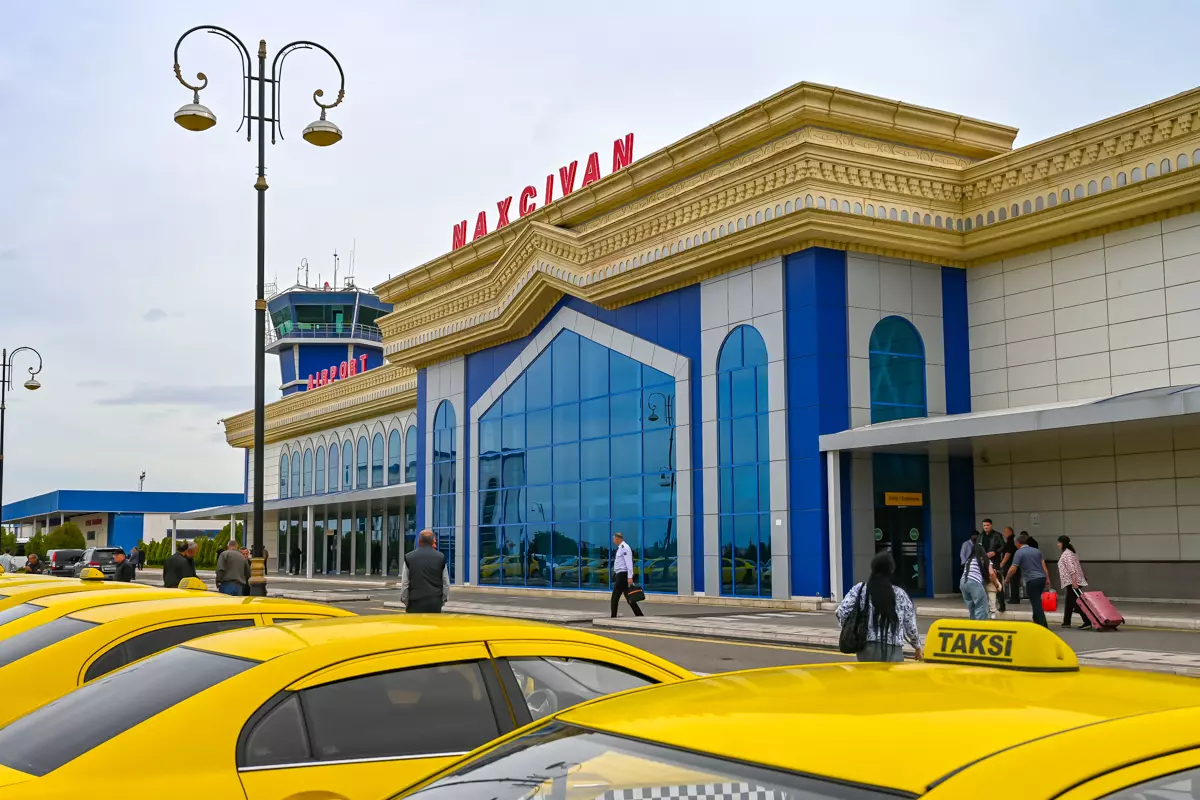
Nakhchivan is a small and very compact region, which makes getting around quite easy. There’s virtually no public transportation, so the main way to move between places is by taxi.
Within Nakhchivan City, you can reach all the main sights on foot. Some attractions are just 10–15 minutes apart, so there’s no need for a car in the city.
Intercity routes are a different story. You won’t be able to reach places like Alinja Castle, Ashabi Kahf Cave, or Lake Batabat without a car. That’s why it’s worth planning your routes in advance and agreeing on a full-day price with the taxi driver. It’ll be cheaper than paying separately for each stop.
If you want to make the most of your time and avoid wasting energy on logistics, the best solution is to hire one driver for the entire day. That’s what I did – and it turned out to be one of the best investments of the trip.
Taxi Cost To Get Around Nakhchivan
Prices in Nakhchivan are very reasonable, but you should always negotiate taxi fares. Most drivers don’t use meters – prices are estimated “by eye,” so it’s important to agree on a rate before the ride. Locals are used to this – no one will be offended if you ask questions or offer a lower price.
Within the city, a short ride (for example, from the airport to your hotel or from a museum to a mausoleum) usually costs €1.5 – €2.5 (3–5 AZN). That typically covers about 10–15 minutes of driving, so it’s not expensive.
If you’re heading farther out – for example, to Duzdag or Alinja – the price depends on the distance and how well you negotiate. If you manage to arrange multiple stops in advance, you can easily reduce the cost by at least a third. It’s also wise to carry cash, as card payments are not accepted.
Taxi Price To Alinja Castle & Ashabi Kahf Cave
When visiting these two sites, I recommend combining them into a single day trip. They’re located in the same direction, so it makes sense to visit Alinja Castle first, then continue on to Ashabi Kahf Cave.
The price for this round trip, including waiting time at both locations, is usually €15 – €20 (30–40 AZN). Most drivers offer a 2–3 hour “package,” during which you visit both sites while they wait in the car. If you’re traveling with one or two others, splitting the fare makes it very affordable.
Be sure to bring water with you, as there are no shops or cafes at either Alinja or the cave. Drivers often carry water themselves or may offer to stop at a spring – so it’s not just transportation, but also a small glimpse into local hospitality.
Taxi Cost To Duzdag Therapy Center & Qarabaghlar Ordubad
These three places can be combined into a full-day itinerary. Since they’re spread out at varying distances, the price will be a bit higher than going to just one destination.
For this kind of trip, it’s also best to agree on a full-day rate. I paid €35 (70 AZN) for the whole day, which included waiting time and additional stops (like for lunch or scenic viewpoints).
If you start with Qarabaghlar, then go to Duzdag, and finish the day in Ordubad, it’s the most efficient plan in terms of both time and logistics. On the way back, you can also stop for a meal in the village of Vadan.
Taxi Price From Nakhchivan To Batabat Lake
A trip to Batabat Lake costs around €50 (100 AZN), depending on how much time you want to spend there and whether the driver will wait for you at the site. Since the lake is located high in the mountains and the road is long, it’s best to agree in advance on a full round trip.
The lake is quite remote, so sharing the ride with other tourists may be difficult – it’s best to go with your own driver.
If you’re planning to visit the lake as an extra activity before your flight, be careful with timing. The round trip, including time at the lake, can take 5–6 hours, so you’ll need to leave early.
Where To Stay In Nakhchivan, Azerbaijan
Nakhchivan is not a large city, so there are not many accommodation options here. Most hotels are privately run local businesses, but they often offer a high level of service, friendliness, and good prices.
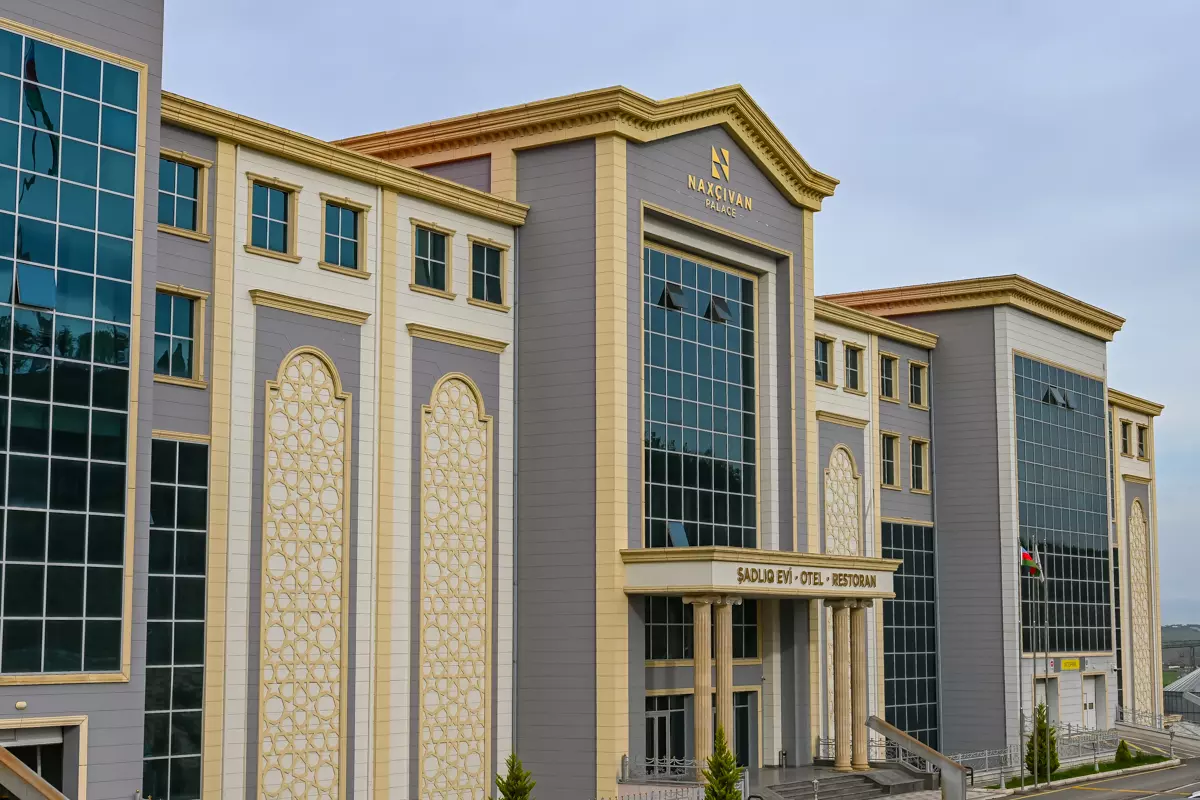
Nakhchivan Palace Hotel
I personally stayed two nights at the Nakhchivan Palace Hotel, which is located in a very convenient area – close to the center, but in a quiet place.
Service: 10 out of 10. The staff were very helpful – from check-in to breakfast, they assisted wherever they could and were friendly.
Breakfast was generous and tasty. There were hot dishes, vegetables, fresh bread, several types of cheese, tea, and coffee.
The rooms were clean, the beds comfortable, and the air conditioning worked well.
One small thing – there was a slight sewage smell in the bathroom, but it didn’t spread into the room, so it wasn’t a major discomfort. On the other hand, it was one of those minor flaws that didn’t change my overall impression.
Tabriz Hotel
This hotel is often considered one of the top choices among visiting tourists. Tabriz Hotel is fairly large, with spacious halls, an elevator, and even a swimming pool. The rooms are a bit dated, but they’re clean and come with all the necessary amenities.
The biggest plus is the stunning view from the upper floors – especially if you get a room facing the mountains. It’s a good option if you’re looking for extra comfort or traveling for business.
Grand Hotel Nakhchivan
If you’re looking for a budget-friendly option, consider Grand Hotel Nakhchivan. It’s a smaller hotel, but it has everything you need for an overnight stay: clean rooms, fresh linens, a shower, and air conditioning.
The hotel is not located in the city center, but it’s in a convenient spot, making it easy to reach the main attractions by foot or taxi. It’s a good choice if you’re looking for a simple, safe, and quiet place to stay at a reasonable price.
Is It Safe In Nakhchivan, Azerbaijan
The short answer – yes, it’s completely safe. And not just safe – this is probably one of the calmest and most secure regions I’ve ever visited. The city is clean, orderly, and the people are very friendly toward tourists. No one hassles you, no one asks for money, no one tries to sell you things – no pushy taxi drivers, no tourist traps.
There’s virtually no crime in Nakhchivan. Locals have a strong respect for order, and you’ll often see police officers in public areas, but their presence never feels uncomfortable. It’s also safe to walk around the city at night.
Tip: As always – use common sense, don’t carry too much cash, and respect local customs (e.g., behave modestly at religious sites). But overall – this is one of those places where I felt more like a guest than a tourist.
Which Tourist SIM Card Is Best For Azerbaijan
If you’re traveling to Azerbaijan and plan to use maps, Google Translate, Bolt, or stay connected, you’ll need a local SIM card. Wi-Fi is only available in some places and is often limited, while mobile internet solves all your connectivity issues.
I chose the Azercell tourist plan and can confidently say it offers the best and most reliable network in Azerbaijan. The internet worked steadily in Baku, Nakhchivan, and even in smaller towns and villages.
Prices are a bit high; the 30 GB plan costs €20 (39 AZN). You can buy a SIM card at the airport, in Azercell stores, or at some shopping malls. Registration is quick – just bring your passport, and the SIM activates within minutes. If I had to choose again, I’d go with the same one.
If you’d prefer not to swap out your SIM card or want to prepare everything in advance, you can also use Holafly eSIM. It works across Azerbaijan, activates in just a few minutes, and is perfect for those who want to keep their WhatsApp number or avoid the hassle of switching SIMs.
FAQs About Traveling To Nakhchivan
Yes, within the city. But if you want to visit castles, caves, lakes, and smaller towns, a car is essential. The best option is to arrange with a taxi driver in advance.
If you plan to visit the main attractions, 2 full days is enough. But if you prefer a slower pace, less rushing, and time to sit with locals or visit places like Batabat, plan for at least 4 days.
Just ask directly. Drivers in Nakhchivan are very approachable – usually, you just mention where you want to go, and they’ll offer a price. Always negotiate, and agree in advance whether they’ll wait and how long stops will be. If you need contacts, I’ve listed the ones I used in the PDF guide.
The only real option is by plane from Baku. Flights operate several times a day. Currently, there are no land routes from neighboring countries – the borders with Iran and Armenia are closed.
Yes. While some places accept cards, many – especially taxis, markets, and smaller cafés – require cash. It’s best to have local manats. Currency exchange is available in both Baku and Nakhchivan.
Book your flight
For the best flight deals, I always rely on Skyscanner. Features like Multi-city and Explore Everywhere help me uncover incredible travel opportunities.
Rent a car
Discovercars is my top choice for comparing car rental prices for any road trip around the world. The booking experience is always smooth and easy.
Travel insurance
SafetyWing provides affordable travel medical insurance with global coverage, perfect for digital nomads and long-term travelers.
Book Tours & Attractions
Experiencing a destination to the fullest is easier with a well-planned itinerary. I use GetYourGuide for guided tours and Tiqets for quick access to museum and amusement park tickets.
Protect yourself online by VPN
No matter where I go, I always use NordVPN for secure browsing and to ensure I can access websites that might be blocked in certain countries.
Disclosure: I only suggest companies that I personally rely on. If you use the affiliate links in my posts to book services, I’ll earn a small commission, with no extra cost to you.
Visited Nakhchivan, Azerbaijan? Share your favorite spot or memory in the comments!
Share on

Hi, my name is Marius, and I’m driven by a desire to explore the hidden corners of the world. Less-traveled destinations like Saudi Arabia, Kazakhstan, and Mongolia fascinate me with their authentic cultures and untouched landscapes. For me, every trip is an opportunity to challenge myself, meet new people, and create memories that last a lifetime.
